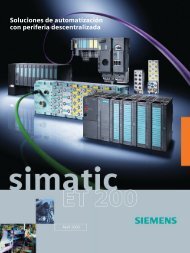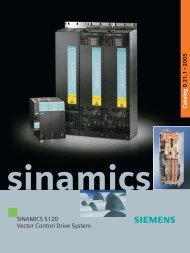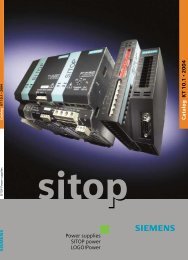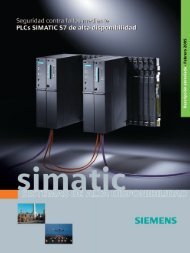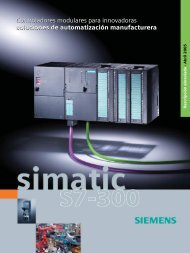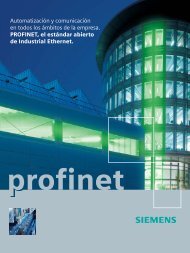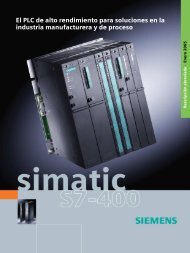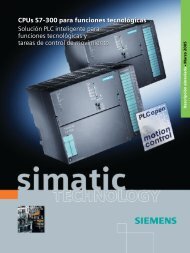SIMATIC PCS 7 process control system
SIMATIC PCS 7 process control system
SIMATIC PCS 7 process control system
You also want an ePaper? Increase the reach of your titles
YUMPU automatically turns print PDFs into web optimized ePapers that Google loves.
<strong>SIMATIC</strong> <strong>PCS</strong> 7 comprehensively satisfies all typical demands<br />
placed on a modern <strong>process</strong> <strong>control</strong> <strong>system</strong>, meaning that<br />
plant owners are appropriately equipped for future requirements.<br />
This is guaranteed by <strong>system</strong> properties such as:<br />
■ High performance, flexibility and scalability<br />
■ Uniform data management, communication and configuration<br />
■ System openness on the basis of internationally established<br />
basic technologies and industrial standards<br />
■ Powerful <strong>system</strong>-wide engineering<br />
■ Simple and reliable <strong>process</strong> <strong>control</strong><br />
■ User-friendly operation and visualization<br />
■ Redundancy at all levels<br />
■ Direct interfacing to the IT world<br />
■ Failsafe automation solutions<br />
■ Comprehensive fieldbus integration<br />
■ Flexible solutions for batch <strong>process</strong>es<br />
■ Incorporation of material transport (Route Control)<br />
■ Asset management (diagnostics, preventive maintenance<br />
and repairs).<br />
Uniform data management, communication and configuration<br />
The advantages of <strong>SIMATIC</strong> <strong>PCS</strong> 7 are already evident during<br />
planning and engineering, but also during installation and<br />
commissioning, everyday operation as well as maintenance,<br />
repairs and modernization.<br />
Uniform data management means that all software components<br />
access a common database. Within a project, inputs and<br />
modifications are therefore only necessary at one point. This<br />
reduces the work required, and simultaneously avoids potential<br />
faults. Data consistency is also guaranteed even if several<br />
persons are working simultaneously on a project. Parameters<br />
defined in the engineering <strong>system</strong> can be transferred beyond<br />
the network limits down to sensors, actuators or drives in the<br />
field.<br />
Uniform communication from the corporate management<br />
level down to the field level is based on internationally recognized<br />
standards such as Industrial Ethernet or PROFIBUS, and<br />
also supports the global flow of information via the Internet.<br />
Since the hardware and software components involved also<br />
use these communications mechanisms, connections are extremely<br />
easy to configure, also cross-<strong>system</strong> or over different<br />
networks.<br />
The use of a central engineering <strong>system</strong> with a uniform and<br />
matched range of tools minimizes the configuration overhead.<br />
The engineering tools for the application software, the<br />
hardware components and the communications functions can<br />
be called from a central project manager (<strong>SIMATIC</strong> Manager).<br />
This is also the basic application for creation, management,<br />
saving and documentation of a project.<br />
<strong>SIMATIC</strong> <strong>PCS</strong> 7, integrated in Totally Integrated Automation<br />
– your advantages<br />
Totally Integrated Automation (TIA) with the <strong>SIMATIC</strong> <strong>PCS</strong> 7<br />
<strong>process</strong> <strong>control</strong> <strong>system</strong> allows cost-effective implementation<br />
and economic operation of I&C plants in all phases of<br />
their life and with consideration of all aspects: from planning,<br />
engineering, commissioning and training, to maintenance<br />
and repair, right up to expansion and retrofitting.<br />
In addition, users enjoy the advantages resulting from the<br />
application of standard <strong>SIMATIC</strong> components, such as:<br />
■ Low hardware and engineering costs<br />
■ Proven quality and stability<br />
■ System components can be defined and selected quickly<br />
and easily<br />
■ Low spare part costs<br />
■ Short delivery times for spare parts and expansion components<br />
■ Worldwide availability<br />
■ Reduced logistics, maintenance and training costs<br />
■ Participation in the innovations of the market leader for<br />
automation technology.<br />
Totally Integrated Automation 5




